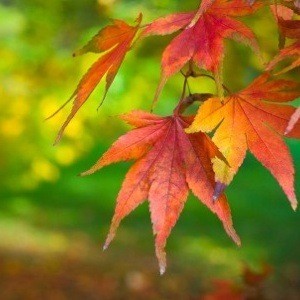Fall is one of the most important times of the year to take care of your trees. By taking a little extra time now to prepare you trees for winter, you'll see the results of your efforts well into the next growing season.
Watering is the number one key to good fall tree care. When your deciduous treed start to lose their leaves, make sure they are still getting plenty of water. It's important that nutrients continue to be delivered to the roots until the ground freezes. Unlike deciduous trees, conifers don't drop their leaves. They need to maintain their foliage throughout the winter. Extra water now will help offset moisture lost to winter winds and help them fend off "winter burn."
Well-established trees should receive a slow deep watering (penetrating the soil 5-6 inches) every 7-10 days. Because young saplings have less developed root systems, they should be watered more frequently, but given less water each time. You want to penetrate the root system, but not overwhelm it so that the roots are constantly wet.
If your area receives adequate rainfall (1 inch or more) during the week, your trees are probably fine. If not, you'll need to make up the difference. Soil conditions, slope, and nearby vegetation all affect how efficiently water soaks into the soil. For example, a lot of rain in a short period of time tends to run off rather than soak into the ground, so you may need to supplement a hard rainfall with additional water.
When watering, don't apply water next to the trunk or you may increase the risk of disease. Start at the outer half under the canopy and extend your watering just beyond the drip line.
Fall (or early spring) is also a great time to give tree roots a boost of fertilizer. Most deciduous trees benefit from an application of fertilizer every two to three years-conifers typically need it less often. One indicator for the need to fertilize is the amount of shoot growth that occurred during the present year.
If you have reasonably fertile soil, fertilize your lawn regularly, or if your trees are located in a wooded area where they are blanketed with leaves every year, you can probably skip the fertilizer. If you're unsure, the best way to find out is with a soil test.
There are several ways to calculate how much fertilizer to apply, each varying slightly based on the age and growth stage of your tree. Again, the most accurate way to determine how much you need is to get a soil test done on one or two of the trees. The results will tell you if you need fertilizer, and if so, what kind and how much to apply.
Mulching is the final step to preparing trees for winter. A layer of mulch 4-6 inches deep starting 6 inches out from the trunk and extending out 1-2 feet will help hold moisture in and keep the ground from freezing early, which encourages the roots to remain active as long as possible. Chopped up leaves, wood chips, or other organic materials work best.
Rodents love tender tree bark, especially when food supplies grow short in the winter. To prevent rodents from burrowing under the mulch to reach young trees, cover the base of the trunk in hardware cloth or wrap it with a plastic tree guard for the winter.

About The Author: Ellen Brown is an environmental writer and photographer and the owner of Sustainable Media, an environmental media company that specializes in helping businesses and organizations promote eco-friendly products and services. Contact her on the web at http://www.sustainable-media.com
Add your voice! Click below to comment. ThriftyFun is powered by your wisdom!
The watering thing is big. I always water until around Thanksgiving, when it gets too cold here in Chicago. I've also started adding compost to the soil before I mulch, so it breaks down over the winter. Here's a good link on a similar vein:
The watering must be one of the reasons that trees grow so well in the Pacific Northwest. All we get is rain from September to December. :)
Add your voice! Click below to comment. ThriftyFun is powered by your wisdom!